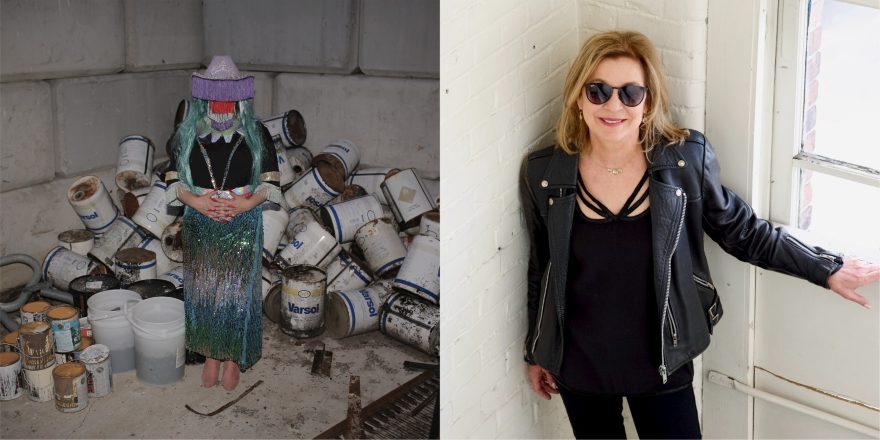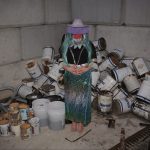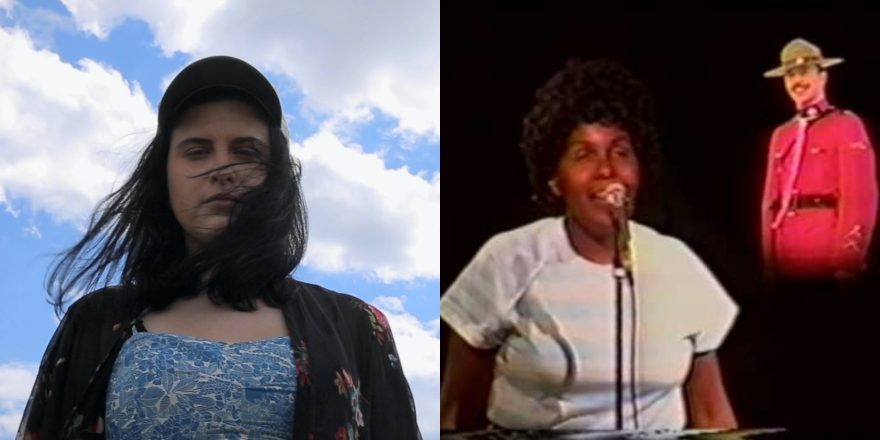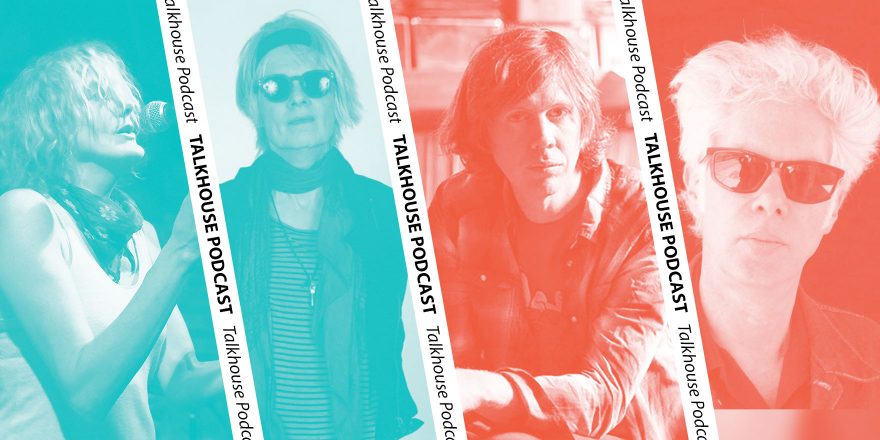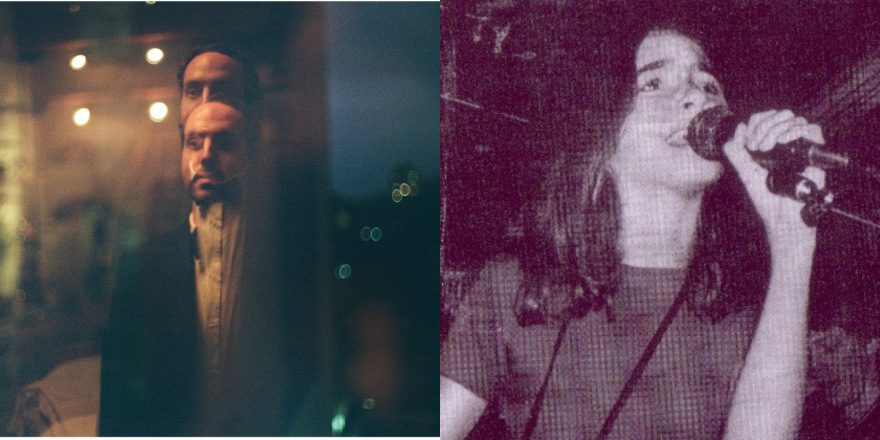Eugenie Diserio is a painter, visual artist, and musician who’s performed with groups like CHANDRA, Model Citizens, and The Dance; Julie Reich is also a Toronto-based multimedia artist who currently performs with CHANDRA, as well as with the band Body Breaks and solo as Bile Sister. Bile Sister is releasing their record Living on the Edge this Friday (via We Are Time), and Model Citizens just reissued their John Cale-produced EP on Modern Harmonic — so to celebrate, the two got on Zoom to catch up about it all.
— Annie Fell, Editor-in-chief, Talkhouse Music
Eugenie Diserio: Hi, Julie. Nice to meet you.
Julie Reich: Nice to meet you too, finally, after all this time.
Eugenie: I know. Well, I listened to the music a few times — very interesting. I think it’s very ‘80s.
Julie: It’s definitely ‘80s, yeah.
Eugenie: Obviously very experimental. Very interesting. The lyrics are great, too. Tell me, where did your name come from?
Julie: Well, actually, it came from a guy named Casper who just called me that one time, and I decided to use it to kind of own that back and make it like a fierce thing. Just the reference to women and how we view our roles…
Eugenie: Yeah. It’s also got a dark side to it. It sort of reflects the darkness in the music.
Julie: My mom was like, “Why did you have to pick something so acidic?” [Laughs.]
Eugenie: [Laughs.] When did you start making all this music and multimedia?
Julie: I started Bile Sister probably in 2012, ‘13, ‘14. I actually started making noise before anything else — I was into sound and I was into noise, and I was part of a small noise community in Toronto, and there were no women. So the few women that would go to shows formed kind of a group, and we would improvise together. That was my first real band experience, and that’s when I really felt like this is kind of a calling for me.
I just kept exploring music. I mean, I have a musical background — I was trained in piano as a kid at the Royal Conservatory, and as a child I remember composing songs on the piano and just thinking, This is different. Like, I didn’t know that anyone else did that. And I guess it just never was noticed, or there was no one to connect with in that way. Then when I started doing music in collaboration with other people, I realized that I did have something and it came from back when I was a kid composing my own music.
Eugenie: I see your guitars on the wall. So you did use instruments to make noise! Was it found stuff?
Julie: Yeah, found instruments. I’ve always been interested in prepared instruments. I did take apart a guitar and I sanded it. I wanted to make a fretless guitar — I’m in a microtonal rock band, so I was interested in microtonal instruments, and I was watching things about Harry Partch and I was just interested in different ways of making sound.
Eugenie: The vocals are very monotonal too, which I really like. That also reminds me of a lot of women’s bands from my era.
Julie: Yeah, I mean, your music too. When you were in the Model Citizens, at least my impression of the way that you performed was very kind of B-52s style. It feels like a sense of urgency, but it’s also fun and playful, and you’re making up your own kind of melodies and things. You’re not really going all the time with the music—
Eugenie: Not at all.
Julie: But it sounds so good.
Eugenie: Well, it’s hard for me to listen to now, but back then they used to call us the New York B-52s. Zappa was a fan, and obviously John Cale produced the record.
Julie: I do wanna know more about these things too.
Eugenie: Well, I always tell people, being an artist and musician in New York in the early ‘80s was just a phenomenal time. So many people came out of that era that, life-changing historical artists. Jean-Michel Basquiat used to eat off our deli tray backstage at the clubs. [Laughs.] That’s how I got connected with Chandra [Oppenheim]. Obviously, I knew her father [artist Dennis Oppenheim] well. You probably know the story, too. My ex-husband, who was in the band, Steve Alexander — we were students at Columbia and we responded to a call for interns at what became MoMA PS1. So the first show in this really crumbling school house had all the top, most creative, crazy artists working in New York and beyond. I always knew Dennis Oppenheim’s work — I was a big fan — but then one thing led to another, and when we saw the way he used Chandra… How did you meet Chandra?
Julie: I actually found the music online after Aaron Levin did that reissue many years ago, in the early 2000s. Then I started this discussion on Facebook with people, talking about the autonomy of children, and children being able to write music and how timeless the music was. So many people found an interest, and Jesse Locke — who is also in the band, and runs with Chandra the We Are Time label — he told me that he knew Aaron Levin, and that he knew Chandra wanted to do another reissue or something, and Aaron just didn’t want to do record label stuff anymore. So he said he could connect us, and maybe I could interview Chandra. So I said, “OK,” and I did an interview with Chandra. I’m not a journalist or anything. I’m just a musician and artist and fan, you know? And I had been doing some covers of the some of the songs from Transportation with my band.
Eugenie: Oh, that’s really cool.
Julie: Yeah. So then when I spoke to Chandra, she brought up wanting to do a reissue, and I offered to help. So we did the reissue, I helped her with it — just going through the process of the vinyl and getting the artwork and putting it together. Then we decided we were going to have a release show, and maybe she could come and sing on a couple of the songs that my band had been performing. So she did, and it went well and we haven’t stopped since.
Eugenie: That’s great. So you’ve been involved together a long time?
Julie: Yeah, it’s been almost 10 years. And it’ kind of amazing because it was the music you guys wrote together.
Eugenie: Well, I never lost touch with Chandra. She’s just so great. I was fortunate to see her a few years ago, actually. It was at a big outdoor sculpture place not far from me; they were honoring her dad, and I got to see Chandra and meet her daughter and her mother. We all got very friendly with her mother because, you know, she was so protective of Chandra. But I think she respected how we handled her early career.
Julie: I can only imagine what that must have been like.
Eugenie: It was really crazy. I mean, it didn’t last that long. The music today is so timeless. The performances, she was great. Just being at the Mudd Club at midnight and one in the morning, and you’re going to this little private school in Brooklyn — after a while, the performing got to disruptive to her life. But, you know, the music, the lyrics she wrote were just amazing. Those songs are so timeless.
So, Julie, tell me: what other artists have influenced you?
Julie: I definitely am a fan of kind of avant garde music, strange music, especially music by women who have maybe not been recognized, things that are more underground. I mean, that’s what drew me to Chandra and the Model Citizens, too. It’s weird because with Bile Sister, I don’t think it sounds like anything else. And that’s always been kind of the goal, but it’s…
Eugenie: It just seems like so many different ingredients are combined, musically, vocally. It’s really interesting. And even though it’s very avant garde and experimental, it’s easy to listen to. I mean, I listened to about three or four times to the whole thing. How long did Living on the Edge take to write and record and refine?
Julie: Oh, gosh. So many years, because I just took time in between. It must be at least six years or more. But I just didn’t proceed for a while. I didn’t feel like it was the right time. Things needed to fall into place, and it just didn’t feel like the right time until now.
Eugenie: You’re a social worker?
Julie: I was a social worker, but then when COVID hit, I went back to school to be an audio engineer for TV and film. So I’ve been working in in TV and film ever since.
Eugenie: That’s great. It’s probably a good career, and it’s good for your work.
Julie: It is. I don’t feel so disconnected now, from being torn between different things, you know?
Eugenie: So what, in your words, is the theme of your music and your work? You did say it has a lot of feminist influences…
Julie: Yeah. It’s [about] supporting women; it’s OK to be kind of aggressive or edgy as a woman. It’s about taking chances being an artist.
Eugenie: Do you think the world is more apocalyptic now than it was?
Julie: Oh, that’s a deep question. Yeah, totally.
Eugenie: I do.
Julie: I definitely worry about the planet a lot.
Eugenie: Yeah. I worry about the globe. Because back in my day in New York, New York was really edgy, it was crumbling. And right now, my youngest son just graduated from NYU — he loves New York. Every time I go in, it’s all so shiny. And, I mean, obviously, there’s a lot of problems, but it’s not the buildings crumbling like it was back in my day. But I still feel like the world is crumbling, even in this idyllic place. I thought your music definitely reflected all the edginess and sort of dystopian kind of stuff that we’re all dealing with, every country.
Julie: Totally. I mean, even the record art, it really mattered showing the nature and pollution aspect of things. And that’s where kind of Bile Sister emerges. She emerges from the filth and the human creation, the disruption that we’ve by our existence created. She’s just like the slime that’s the result of all the stuff that we’ve done to this planet.
Eugenie: Yeah, I picked up on that, too. I wanted to ask you, why did you disguise yourself in your photo?
Julie: Well, it was COVID when we did the photo shoot. [Laughs.] So the masks were kind of a thing. But I do feel like Bile Sister’s an identity. She’s not me, she’s somebody else, and I needed to become that character. That is the closest I’ve come to who that character is. And I have to do that when I’m on stage, too — I can’t explain it. Maybe it’s the way people feel when they’re in drag or something. You just take on this larger than life identity, or someone else that you can’t be. It’s that. And I don’t I don’t think she needs a face. She kind of represents something else.
Eugenie: When you perform, you’re disguised?
Julie: I have in the past. Actually, it’s never worked out, but I have tried to commission someone to make a face mask or face piece or something. I am always trying to figure that out. There are some things that I do — I have a lot of gemstones that I put all over. I usually cover some part of my face, actually.
Eugenie: That’s interesting. I think it’s very intriguing.
Julie: How does that relate to you as an artist?
Eugenie: Well, I mean, first of all, like you said, it takes the identity away from you personally. It becomes more like an archetypal figure, and a mythical figure. So the idea of being like a character and kind of disguised, I just think it’s really it goes with the music.
Julie: Yeah, it totally goes with the music. And I think I needed all those visuals to really sell it. The visuals matter so much to me. They really do tell a story, and I think that story needs to be part of understanding the music.
Eugenie: You said you put jewels on. What do you do with that? I use a lot of stones in my paintings.
Julie: Oh, nice. I put them all over my eyebrows. It’s definitely nice on stage because it catches the light, but it also kind of changes my appearance. I can change my eye shape, I can make new eyebrows with them. How do you use them in your in your artwork?
Eugenie: Several years ago, I started using artist grade glitter and gold leaf to make areas that were reflective in the paintings. Because reflections, they’re kind of historically communicating with the spirit world, obviously even going back to early Renaissance things with all the gold and stuff. Then recently I started using little Swarovski crystals — it’s really very meditative, using, a little tweezer and putting them in. It’s not the whole painting, but just areas that, like you say with your face, pop up, reflect the light.
Julie: It’s interesting because I’ve used mirrors — I focus on music but of course, you find yourself doing other things when you’re collaborating with tons of people and you get more and more involved. And I found myself really being into mirrors and reflections, projecting onto mirrors because I love I love how the light doesn’t go directly where you think it would go. It’s cool when you use shaped mirrors, because the projection is framed in that shape. I always love that kind of element for live performance. It’s kind of a dream to do that on a big scale one day.
I have a bunch of questions for you, too. I’m excited for for this album to come out, and it is super sweet and precious that Chandra’s label is the one that is putting it out. It’s nice to kind of keep it in the family in a way, talking to you about all this. I mean, I’m able to put out this LP is because of Chandra, and you were in her original band. I’m in her band now. It just makes so much sense. So I guess I wanted to ask you what your impression of her was as a kid, working with her on those songs.
Eugenie: Well, we always knew Chandra, because she did performance art with her father that was really haunting and demonic. You probably saw the pictures of her holding the dummies that Dennis would use with the knife in the back. And Chandra was, like, six or something — innocent little girl’s face, and she’d recite things. So he basically had made her a sort of art world mini performer, and one thing led to another. I can’t even remember; maybe it was Dennis that said Chandra had just started writing poems and lyrics, and Dennis was a fan of Model Citizens. Steve and I thought like, Let’s see if we can make songs around Chandra’s lyrics. She wrote all the lyrics and obviously did all the vocals; we wrote the music around it. She’d play the melodica. Her mother, Phyllis, would bring her over after school to this horribly dumpy building — where, actually, Madonna was, and everybody was in. It was across from Penn Station.
Julie: I heard about that!
Eugenie: An old fabric building. It was really disgusting. And her mother would bring her over, and we’d practice an hour or so. And then there was one point where we did have peer-aged musicians, but that was really hard to keep together. Too many kids.
Chandra, I mean, she was just like a normal kind of kid. We were very respectful of Phyllis, her mother, because she was trying to keep everything really normal. It was enough that she was exposed to the wacky parts of the super avant garde art world from her dad. But her dad adored her. He’s a really good dad to her and his other children. She was just one of these creative, precocious kids, but she was kind of modest, too, you know? She never acted like she was phenomenal. And she was.
Julie: She still is modest. I definitely want to know how you guys came into working with John Cale, to do that Model Citizens EP.
Eugenie: The meeting of John Cale wasn’t really as exciting as you may think. Everybody was in the clubs back then; John Cale, I guess, had seen the band and he was starting his own label called Spy Records. And this woman named Jane Friedman — who’s still alive and working in New York in the arts today — they were romantic partners and business partners. I think she managed Patti Smith. Anyway, she basically thought we’d be a good fit, so we were invited. He picked out the songs. In the studio, we didn’t have that much interaction. He was behind the glass, we did our performances. The record came out, some people in the band didn’t like the production, some people did. And that was the only record the Model Citizens ever got out. There was a big guy at Warner Brothers kind of after us, but the band was just too much weirdness going on. The band kind of dissolved. But if you read the liner notes that come with the new re-release by this guy Tim Page, who was a big fan back then, he pretty much said we were not meant to be around that long. You know, we did what we had to do.
Julie: I just can’t understand that feeling, I guess. I’ve left bands before where I felt like I couldn’t be in the band anymore. But I just don’t know what that feels like to say, “This is has reached its [end].
Eugenie: You know what it is though? We were graduate students, and it was it was like, “Hey, Talking Heads went to RISD, they formed a band. Let’s form a band.” We were all kind of tired of making visual art and painting and stuff. And it was this thing that it was going to be a four way collaboration, and there was no leader. Everyone was equal, so everybody wrote songs, we all traded off on vocals. And then it got to where there was a real edge between me and Steve and Gloria [Richards] and Tomek [Lamprecht]. We were the four leaders, so it just. It just fractured. And our bass players at the time, Billy Robertson, got a big deal with CBS. He had a band called Polyrock that was sort of known in the ‘80s. But the songwriting was just sort of collaborative in Model Citizens.
Julie: Would you ever do anything like that ever again?
Eugenie: No. I mean, I’m really, really honored that the music has all been rereleased after 40 years, and I’m really happy with all the designs and everything, but no. I paint. I have no desire like the Bush Tetras — they are still performing today. They tour and they put out new records. I don’t have any desire to make any music. I’m just happy to paint. That’s what I do.
Julie: I know that feeling, because I’ve had to choose as well. You can’t do everything, and sometimes you just need to focus on one thing so that you can really become an expert at it.
Eugenie: Yeah. And I gave up painting for a really long time. I love the music. It’s just so unwieldy to perform it, and I really don’t know too many people from my era except Bush Tetras and, well, David Byrne.
Julie: I mean, it’s one thing to tour and play live, but it’s another to record. I feel like that is more accessible. I mean, I envision how I’m going to age with music too, and everything like that. I have a setup here in my home studio and I can record any time that I want to. And I would say that, of course, I dream of you doing something again. But that’s just me.
Eugenie: Well, I can’t say I wouldn’t think about it. Maybe after the record comes out and starts to get a little bit of buzz, we can catch up again.
Julie: I would love that.
(Photo Credit: left, Natalie Logan)



